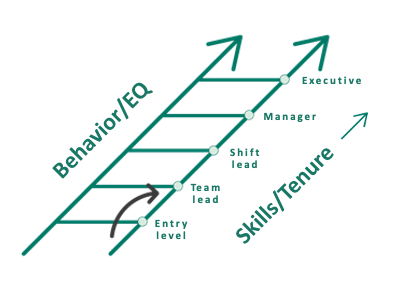Leadership Ladder: Helping your Leaders Stay Balanced
As a business leader, you may spend a great deal of time considering how you can develop dependable leaders and scale the business. Hiring, promoting, and retaining high-performing leaders is essential for growth, but even the best business leaders find it challenging.
As we partnered with leaders and organizations from all over the country, we started to hear a common theme: “My top-performing leader was promoted and is now struggling to succeed.” From this concern, we created a concept called the Leadership Development Ladder.
Raising Up Leaders
Leaders are often promoted based on tenure or skills– their time spent with the organization or their ability to successfully complete their tasks. They master the skills associated with their current role, so they get promoted to the next level. With each promotion, they are expected to learn the new skills of their new role, while training others on the skills of their previous role. It typically looks something like this: an employee starts as a team member, promotes to a team leader, then shift manager, to general manager, and so on. This typical promotion structure looks like a line. However, we’ve found it actually functions more like a ladder.
Balanced Leaders
The right side of the ladder represents the skills, expectations, and role definitions required at every level. But the left side of the ladder represents behaviors, leadership skills, and emotional intelligence- these items seem less tangible, but they are equally necessary for leaders to be successful at any given level. What we often see is that leaders who are promoted have the experience and skills to reach a higher level in the organization but are less prepared for higher level behaviors and the leadership skills required. This gap causes them to be out of balance.

Leaders who are out of balance may struggle with engaging others on the team, gaining buy-in, or building trust, despite being skilled in other role functions. This often causes them to revert to less effective styles of leadership to get the job done which can have lasting negative effects on the team or organization.
Scaling Culture
When an organization is smaller, it’s easier for the leaders to be unified about their culture because they’re doing life together more. As businesses begin to expand, the number of teams are increased, new roles are created, and new systems are implemented. Adding new layers can cause the culture to become less defined and more confusing. Some employees, especially new hires, may have a hard time fitting into the new and unspoken culture. Legacy employees wonder why the newer members cannot support the past culture they have always shared. They reminisce longingly to how “wonderful things used to be.”
One way we partner with organizations to overcome these challenges is to help teams define what this “left side of the ladder” looks like. We help teams develop leadership skills, increase emotional intelligence, and multiply impact through a blend of various personality assessments and personalized coaching experiences. Our unique Culture Brand™ concept allows teams to have a common language about the behaviors and team culture that best support the mission and vision of the organization, bringing definition and clarity to the left side of the leadership development ladder.
Once culture is defined, we guide organizations to clarify the “right side of the ladder” items, such as: role clarity, ownership, accountability, and execution. When alignment is established on the right and left side of the ladder, individuals are equipped to win in their role and support the goals of the team, ultimately increasing productivity, efficiency, and retention.
To learn more about how Culture Brand™ has benefited the clients we serve, listen to our podcast:
Interested in designing a measurable culture that fits you? Book a free consultation with Jay using the button below to find out more about how we can partner together to help guide your team toward health and high-performance.

